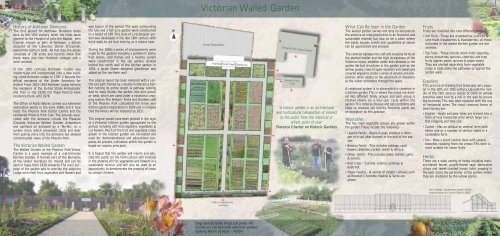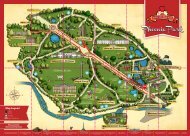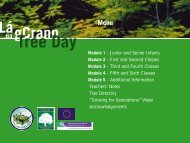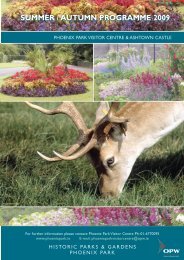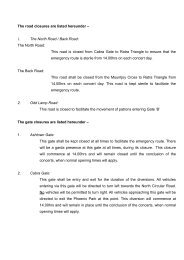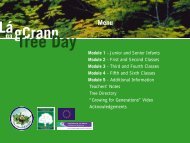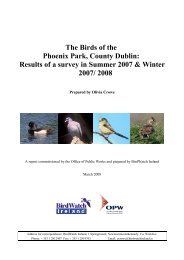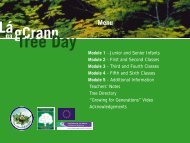Victorian Walled Garden - Phoenix Park
Victorian Walled Garden - Phoenix Park
Victorian Walled Garden - Phoenix Park
You also want an ePaper? Increase the reach of your titles
YUMPU automatically turns print PDFs into web optimized ePapers that Google loves.
<strong>Victorian</strong> <strong>Walled</strong> <strong>Garden</strong><br />
History of Ashtown Demesne<br />
The first record for Ashtown Demesne dates<br />
back to the 12th century when the lands were<br />
granted to the Hospital of John the Baptist. John<br />
Connell, known as John of Ashtown, a distant<br />
ancestor of the Liberator, Daniel O’Connell,<br />
owned the castle in 1641. At that date the estate<br />
consisted of 200 acres and records show that<br />
there were also two thatched cottages and a<br />
small orchard.<br />
In the 18th century, Ashtown Castle was<br />
modernised and incorporated into a new building,<br />
called Ashtown Lodge. In 1782 it became the<br />
official residence of the Under Secretary for<br />
Ireland. From 1922-1929 Ashtown Lodge became<br />
the residence of the United States Ambassador<br />
and then in the 1930s the Papal Nuncio took<br />
residence there until 1978.<br />
The Office of Public Works carried out extensive<br />
restoration works in the early 1990s and it now<br />
hosts the <strong>Phoenix</strong> <strong>Park</strong> Visitor Centre and the<br />
renowned <strong>Phoenix</strong> <strong>Park</strong> Cafe.The grounds associated<br />
with the demesne include the Pleasure<br />
Grounds, <strong>Victorian</strong> <strong>Walled</strong> <strong>Garden</strong>, Arboretum<br />
and parkland all enclosed by a 'Ha-Ha’, i.e. a<br />
sunken fence which prevented cattle and deer<br />
from gaining entry into the demesne but allowed<br />
uninterrupted views of the <strong>Phoenix</strong> <strong>Park</strong>.<br />
The <strong>Victorian</strong> <strong>Walled</strong> <strong>Garden</strong><br />
The <strong>Walled</strong> <strong>Garden</strong> at the <strong>Phoenix</strong> <strong>Park</strong> Visitor<br />
Centre is a good example of a mid-<strong>Victorian</strong><br />
Kitchen <strong>Garden</strong>. It formed part of the Demesne<br />
of the Under Secretary for Ireland and can be<br />
seen in maps from 1838 onwards.The main purpose<br />
of the garden was to provide the adjoining<br />
Lodge with fresh fruit, vegetables and flowers and<br />
was typical of the period. The walls surrounding<br />
the two and a half acre garden were constructed<br />
to a height of 16ft.This style of a rectangular garden<br />
was developed in the late 18th century with<br />
brick walls to aid fruit training, as it retains heat.<br />
During the 1850s a series of improvements were<br />
made to the gardens including a gardener’s bothy,<br />
fruit stores, cold frames and a heating system<br />
were constructed in the slip garden, located<br />
behind the north wall of the kitchen garden. In<br />
1854, a Jacob Owen designed glasshouse was<br />
added on the northern wall.<br />
The original layout has been restored with a central<br />
axis path framed by a double herbaceous border<br />
running its entire length. A pathway running<br />
east to west divides the garden into four panels<br />
or beds, which are used under a rotational cropping<br />
system.The Historic <strong>Park</strong>s and <strong>Garden</strong>s staff<br />
of the <strong>Phoenix</strong> <strong>Park</strong> completed the three year<br />
kitchen garden restoration in 2009 and it is hoped<br />
that the Vinery will be restored by 2011.<br />
The original panels have been planted in the style<br />
of a <strong>Victorian</strong> kitchen garden appropriate to the<br />
period, including soft fruit, espaliers, vegetables &<br />
cut flowers. Much of the fruit and vegetable crops<br />
grown in the kitchen garden are harvested and<br />
used for demonstrational and educational purposes.At<br />
present, cultivation within the garden is<br />
based on organic principals.<br />
It is hoped that the garden will inspire and educate<br />
the public on the horticultural skill involved<br />
in the growing of fruit, vegetables and flowers in a<br />
sustainable manner and will also be used as an<br />
opportunity to demonstrate the growing of crops<br />
to school children.<br />
‘A historic garden is an architectural<br />
and horticultural composition of interest<br />
to the public from the historical or<br />
artistic point of view’<br />
Florence Charter on Historic <strong>Garden</strong>s<br />
What Can Be Seen in the <strong>Garden</strong><br />
The walled garden serves not only to educate on<br />
the practice of crop production in an historical and<br />
sustainable manner, but also to be a place where<br />
the sights, sounds, scents and capabilities of nature<br />
can be appreciated and enjoyed.<br />
The contrast between the soft and creeping forms of<br />
the planted matter and the rigid straightness of the<br />
<strong>Victorian</strong> layout, establish order and calmness in the<br />
garden.Vertical structures in the garden such as the<br />
willow panels, rows of apple espaliers and sweet-pea<br />
covered wigwams create a sense of volume and proportion,<br />
while adding to the adventure of discovery<br />
as the visitor orientates through the space.<br />
A rotational system is in place,which is common in<br />
a kitchen garden.This is where the crops are divided<br />
into different family groups and each group is<br />
rotated ideally on a four-year cycle within the<br />
garden.This reduces disease and pest problems and<br />
helps to improve soil fertility. Perennial plants are<br />
an exception to this practice.<br />
Vegetables<br />
The five main vegetable groups are grown within<br />
the garden.These include the following:-<br />
• Legume Family - Beans & peas, produce a nitrogen<br />
rich soil after harvest at the end of the season.<br />
• Brassica Family - This includes cabbage, cauliflower,<br />
calabrese, rocket, radish & lettuce.<br />
• Onion Family - This includes leeks, shallots, garlic<br />
& onions.<br />
• Root Crops - Carrots, celeriac, parsnips &<br />
beetroot.<br />
• Heavy Feeders - A variety of potato cultivars such<br />
as Rooster, Charlotte, Nadine & Sante are<br />
grown.<br />
Fruits<br />
Fruits are classified into two different groups.<br />
• Soft Fruits - These are strawberries, currants &<br />
cane fruits (raspberries & blackberries), all those<br />
cultivated in the walled kitchen garden are old<br />
varieties.<br />
• Top Fruits - These include stone fruits (peaches,<br />
plums, nectarines, apricots, cherries) and tree<br />
fruits (apples, pears, quinces & grape vines).<br />
They are planted separately from vegetable<br />
crops in beds along the pathways or against the<br />
garden walls.<br />
Espaliers<br />
This practice of training fruit trees was very popular<br />
in the 18th and 19th century. Up until the middle<br />
of the 19th century pieces of cloth or willow<br />
branches were tied to a nail in the wall to secure<br />
the branches.This was later replaced with the use<br />
of horizontal wires. The most common forms of<br />
tree training are:<br />
• Espalier - Apple and pear trees are trained into a<br />
form of long horizontal arms which helps control<br />
cropping and tree size.<br />
• Cordon - Has an oblique or vertical form with<br />
either one or a number of vertical stems in a<br />
candelabra form.<br />
•Fan- Have a short central stem with several<br />
branches radiating from the crown.This form is<br />
most suitable for stone fruits.<br />
Herbs<br />
There are a wide variety of herbs including feathery-leaved<br />
fennel, purple-leaved sage, decorative<br />
chives and sweet-scented lemon balm, growing in<br />
the beds along the perimeter of the garden, where<br />
they are sheltered by the willow panels.<br />
Dogs (except Guide Dogs), ball games and<br />
bicycles are not permitted within the gardens.<br />
Opening Hours: 10.00am – 4.00pm
<strong>Phoenix</strong> <strong>Park</strong> Visitor Centre<br />
<strong>Victorian</strong> <strong>Walled</strong> <strong>Garden</strong><br />
PHOENIX PARK<br />
VISITOR CENTRE<br />
DUBLIN<br />
Herbaceous Border<br />
The double herbaceous border, with its vibrant<br />
colour scheme of cool white, blues and purples at<br />
the garden entrance transforming and fusing into<br />
hot reds, yellows and oranges by the far end of<br />
the vista, is a beautiful feature but also a vital<br />
component of the garden. It brings life and sound<br />
to the garden with its bright and scented flowers<br />
attracting important pollinating insects such as<br />
bees and butterflies. The lavender variety,<br />
Munstead, another deeply scented and attractive<br />
flowering plant, and the box plant Buxus suffruticosa<br />
are used for hedging in the garden.<br />
Seasons in the <strong>Garden</strong><br />
Check out the gardens to see some of the following<br />
seasonal activities:-<br />
SPRING – The seeds are selected, soils are prepared<br />
and crops such as broad beans, parsnips,<br />
radish, peas and spinach are sown while shallots,<br />
artichokes, rhubarb, onion and spring cabbage<br />
varieties are planted.<br />
SUMMER – A wide range of crops flourish such as<br />
sweet corn, peas, beetroot, lettuce, endives, strawberries,<br />
blackcurrants, rhubarb and cabbage.<br />
Fantastic displays of colour can be seen such as<br />
the flower displays of sweet pea, bellflowers and<br />
sunflowers.<br />
AUTUMN - The pumpkins that have been growing<br />
on raised mounds with the protection of a<br />
scarecrow are ready to harvest. Autumn Bliss<br />
raspberries, blackberries, and redcurrants have<br />
ripened. Green manures such as rye grasses, winter<br />
vetch and crimson clover are also sown in<br />
autumn and left there until mid-spring to improve<br />
the soil structure.<br />
WINTER – While most plant matter may look<br />
dead at this time of year, beneath the ground root<br />
crops such as carrots, parsnips, beetroot or salsify<br />
are ready to be harvested.Also in the garden<br />
are varieties of Swede 'Magres' and Turnip<br />
'Snowball', which are not harvested until<br />
December as the cold temperature improves the<br />
vegetables taste.<br />
Education & Interpretation<br />
A lively and entertaining exhibition on the history<br />
and the wildlife of the <strong>Phoenix</strong> <strong>Park</strong> is on display<br />
in the Visitor Centre. Here the visitor can<br />
enjoy a historical interpretation of the <strong>Park</strong> from<br />
3,500 B.C. to the present day and also an audiovisual<br />
on the <strong>Phoenix</strong> <strong>Park</strong> through the ages or on<br />
the history of Áras an Uachtaráin. The staff at the<br />
Visitor Centre provide an extensive programme<br />
of events throughout the year.A number of publications<br />
are on sale including ‘An illustrated history<br />
of the <strong>Phoenix</strong> <strong>Park</strong>, Landscape and Management<br />
to 1880’ by Dr J McCullen. The new children’s<br />
playground beside the walled garden is a must for<br />
all parents and kids alike.<br />
Meet the <strong>Garden</strong>ers<br />
The Kitchen <strong>Garden</strong>s are managed by the<br />
Historic <strong>Park</strong>s & <strong>Garden</strong>s Staff of the Office of<br />
Public Works. <strong>Garden</strong>ing workshops and talks<br />
take place on a regular basis. Meet the gardeners<br />
on the second Saturday of each month at 10.30<br />
a.m. at our ‘Green Fingers' Workshop and learn<br />
about growing your own fruits, vegetables and<br />
flowers.<br />
Check out www.phoenixpark.ie for further<br />
details<br />
M50<br />
City Centre<br />
CONTACT DETAILS:<br />
<strong>Phoenix</strong> <strong>Park</strong> Visitor Centre: 01-6770095<br />
Email: phoenixparkvisitorcentre@opw.ie<br />
<strong>Park</strong> Superintendent’s Office: 01-8205800<br />
Email: superintendent.park@opw.ie<br />
www.phoenixpark.ie<br />
Historic <strong>Park</strong>s & <strong>Garden</strong>s


